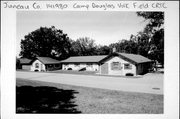Property Record
VOLK FIELD CRTC
Architecture and History Inventory
| Historic Name: | Former Buildings 313 and 314 |
|---|---|
| Other Name: | Building 313 |
| Contributing: | |
| Reference Number: | 141980 |
| Location (Address): | VOLK FIELD CRTC |
|---|---|
| County: | Juneau |
| City: | Camp Douglas |
| Township/Village: | |
| Unincorporated Community: | |
| Town: | 17 |
| Range: | 2 |
| Direction: | E |
| Section: | 21 |
| Quarter Section: | |
| Quarter/Quarter Section: |
| Year Built: | 1940 |
|---|---|
| Additions: | |
| Survey Date: | 2006 |
| Historic Use: | dining hall |
| Architectural Style: | Front Gabled |
| Structural System: | Masonry |
| Wall Material: | Tile |
| Architect: | Hengels, Henry C. |
| Other Buildings On Site: | |
| Demolished?: | No |
| Demolished Date: |
| National/State Register Listing Name: | Not listed |
|---|---|
| National Register Listing Date: | |
| State Register Listing Date: |
| Additional Information: | This building originally was two separate enlisted men's mess halls built in 1940 for the 135th Medical Regiment. The mess hall was designed by Lt. Colonel Henry C. Hengels, State of Wisconsin Military Architect and Engineer. The permanent mess hall was divided into two spaces: a kitchen and a dining area. The building could accommodate 100 persons and was oriented so that the dining area faced the troop encampment. Troops accessed the building through double doors that occupied the front gable end. The kitchen at the rear of the building had a separate single door. The 1940 design of the permanent mess halls had an interior brick chimney (retained in former Building 313) and an exterior icebox door located near a corner of the kitchen (retained in former Building 314). Each individual mess hall measures 25 x 65 feet and rests on a stuccoed concrete wall foundation. The exterior walls are constructed of tan clay tile with red brick corner quoins. The gable roof is sheathed with composition shingles. Exposed purlin ends project from the end walls; the current eave is sheathed in metal. Each upper gable end wall is finished with a band of red brick and has a rectangular wood louvered vent with canted corners. The windows are wood-frame, six-over-six-light and three-over-three-light, double-hung sash. The windows have wood lintels and concrete sills. The original doorway was located in the north elevation and contained a pair of double wood doors. The door currently is infilled with tan clay tiles, but the original wood lintel with its brick surround remains. The exterior icebox door on the end of former Building 313 was infilled with similar clay tile, but the icedoor on the rear elevation of former Building 314 remains. The original doorway on the south gable end was infilled and made into a window. A few original window shutters have been retained. After the property was leased for use by the Air National Guard in 1954, this building was converted into barracks. In 1978, Buildings 313 and 314 were joined by a wood-frame addition clad in horizontal wood siding to renovate the building into a telecommunications center. The buildings were upgraded to year-round habitability through the addition of indoor plumbing and heat. |
|---|---|
| Bibliographic References: | Volk Field CRTC, real property records, drawings files. Wisconsin National Guard Review, May 1940:5. Wisconsin Veterans Museum Archives, Madison, blueprint drawings, Camp Williams. Wisconsin National Guard Museum, Volk Field CRTC, 1955 Conditions Survey. |
| Wisconsin Architecture and History Inventory, State Historic Preservation Office, Wisconsin Historical Society, Madison, Wisconsin |

